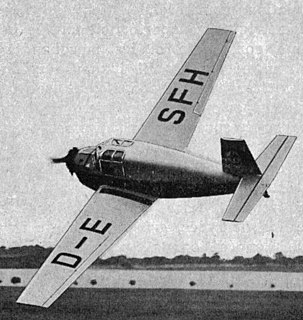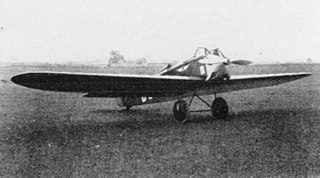
The BFW M.20 was a German single-engine, high-wing monoplane ten-seat passenger transport aircraft, developed in the late 1920s and early 1930s. Deutsche Luft Hansa used it throughout the 1930s on a variety of routes.

The Fokker F.XIV was a cargo plane built in the Netherlands in the late 1920s by Fokker. It was a high-wing cantilever monoplane of conventional trimotor layout. The sole example was tested by KLM but never put into service.

The ICAR 36 / ICAR Comercial (sic), variously also known as the ICAR M 36, Messerschmitt M 36 or BFW M.36, was a Messerschmitt design built and tested by the Romanian company ICAR in the mid-1930s. It was a small, single-engine high-wing airliner, the first civil transport aircraft built in Romania.

The Bayerische Flugzeugwerke M 18, was an airliner, produced in Germany in the late 1920s.
The Messerschmitt M 24, otherwise known as the BFW M.24, was an airliner developed in Germany in the late 1920s as a further development in the series of designs produced by Messerschmitt, based on the M 18. Like the M 18 and its follow-on, the M 20, it was a high-wing cantilever monoplane with a fully enclosed cabin and fixed tailwheel undercarriage. It was slightly smaller than the M 20, seating only eight passengers instead of the ten that could be carried by the previous aircraft.
The Messerschmitt M 28 was a mail plane developed in Germany in the early 1930s to meet a requirement by Deutsche Luft Hansa. It was a single-engine, low-wing cantilever monoplane of conventional design with an enclosed cockpit and fixed, tailskid undercarriage.

The BFW M.23, sometimes known as the Messerschmitt M 23, was a 1920s two-seat sporting aircraft designed by Willy Messerschmitt, and produced by Bayerische Flugzeugwerke (BFW). Examples won several prestigious races in 1929 and 1930.

The BFW M.35, sometimes known as the Messerschmitt M 35, was a German sports plane of the early 1930s. It was the last of a line designed by Willy Messerschmitt.

The Siebel Si 202 Hummel ("Bumble-bee") was a German light sportsplane of the late 1930s. It was an angular low-wing monoplane, which could be powered by a variety of small engines.

The BFW M.27, sometimes known as the Messerschmitt M.27, was a German two-seat sports plane with a low, cantilever wing, open cockpits and a fixed undercarriage sold in small numbers at the start of the 1930s.
The BFW M.19, sometimes known as the Messerschmitt M 19, was the first in a line of German low-wing single-engine sports planes, designed by Willy Messerschmitt while he worked for Bayerische Flugzeugwerke (BFW).
The BFW M.29 was a single-engine two-seat low-wing aircraft, designed by Willy Messerschmitt for the 1932 Circuit of Europe races.

The Bristol Type 148 was a two-seat, single-engine low-wing monoplane built in 1937 to an Air Ministry specification for an army cooperation aircraft. It lost in the competition to the Westland Lysander and did not progress past the two prototypes that were built.

The BFW M.21 was a single-engined biplane trainer designed by Willy Messerschmitt for the German Ministry of Transport. It was one of only two biplanes Messerschmitt designed, neither reaching production.
The BFW M.22 was a twin-engined medium bomber, designed by Willy Messerschmitt for the German Ministry of Transport. It was one of only two biplanes Messerschmitt designed, both unsuccessful.
The BFW M.26 was a single-engined cantilever-winged monoplane light airliner built in Germany in 1930. There were no sales and only one was built.

The Mitsubishi 1MF10 or Mitsubishi Experimental 7-Shi Carrier Fighter (七試艦上戦闘機) was a prototype Japanese monoplane single-seat carrier-based fighter aircraft of the 1930s. Two were built for the Imperial Japanese Navy, but both were lost in crashes, with no production following.

The Udet U 1 was the first of a line of small, low-powered, low wing, cantilever monoplanes built in Germany in the early 1920s.
The Gribovsky G-10 was a single seat sports aircraft designed and built in the USSR in the early 1930s.

The Caproni Ca.95 was a large, three engine, long range, heavy bomber prototype built in Italy in 1929. It could carry a 1,600 kg (3,500 lb) bomb load and had three defensive gun positions. Only one was built.














